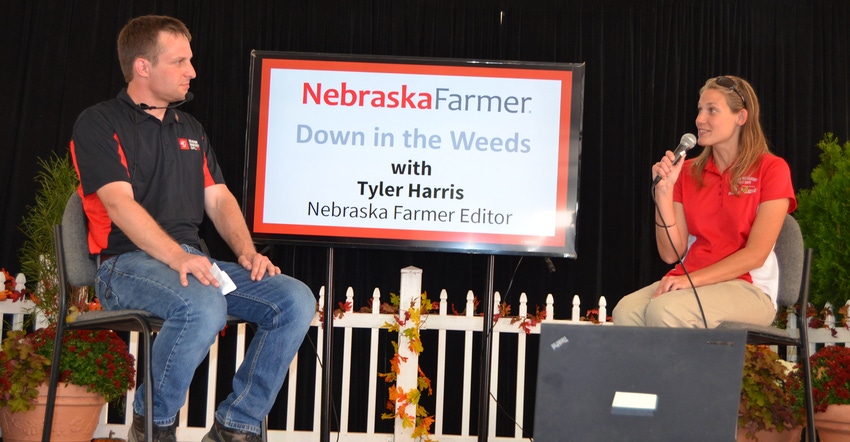September 2, 2019

Readers who have been following along with the “Down in the Weeds” podcast series — and anyone else who’s interested in learning about agronomic practices, research and managing farm operations in tough times — will want to check out live recordings of podcast interviews at the Nebraska Farmer Hospitality Tent on Lot 33 during Husker Harvest Days.
The podcasts, hosted by Tyler Harris, editor of Nebraska Farmer, cover a broad range of agronomy, ag tech and management-related topics.
According to Harris, the podcast format allows a more in-depth, detailed discussion of often-complex subjects. Essentially, podcasts allow the discussion to get “down in the weeds.”
2019’s flood events
In a recent podcast, Harris talked with John Wilson, Nebraska Extension educator, on the impact of the 2019 flood, how it compared to the 2011 Missouri River flood, and steps farmers and ranchers can take to clean up residue and debris, and fix erosion as a result of flooding.
“In 2011, we had a real narrow corridor, probably 3 to 5 miles wide on either side of the Missouri River, depending on the topography where we had very severe, very complete damage in those areas. But once we got outside that corridor, it was another normal year, for most folks,” he said. “This year, because of the extent of the flooding, it was over a much wider area of the state, and we had some places with extreme sand and silt deposition, other places not so much. We were fortunate this year in that we were one of the areas that didn’t have quite the damage we experienced in 2011.”
Flooding this spring left sand, silt, cornstalk residue and debris deposited in fields across eastern Nebraska. And although the amount of sediment deposited may not have been as severe as it was in 2011, Wilson says some areas were still dealing with 3 to 5 feet of sand, and many places in east-central Nebraska had large amounts of cornstalks deposited over the entire field.
Wilson offered methods to incorporate deposited silt and sand.
“The thing we need to remember is however deep the sand or silt is on top of the native soil, we want to incorporate it 1.5 times that depth,” he said. “So if we have 4 inches of sand out there on top of a field, we need to be able to till at least 10 inches deep. It may depend on the equipment we have available to us whether we can do that or not. We’re going through the 4 inches of sand, and then 1.5 times that, or 6 inches of native soil, to incorporate that in. For shallow depositions, that’s the easiest way to handle that.”
To check out this podcast and more, visit soundcloud.com/nebraska-farmer.
Catch the live recordings at HHD this year. They are open to anyone and will take place each day of the show at noon at the Hospitality Tent stage at Central Avenue and Main Street.
You May Also Like




